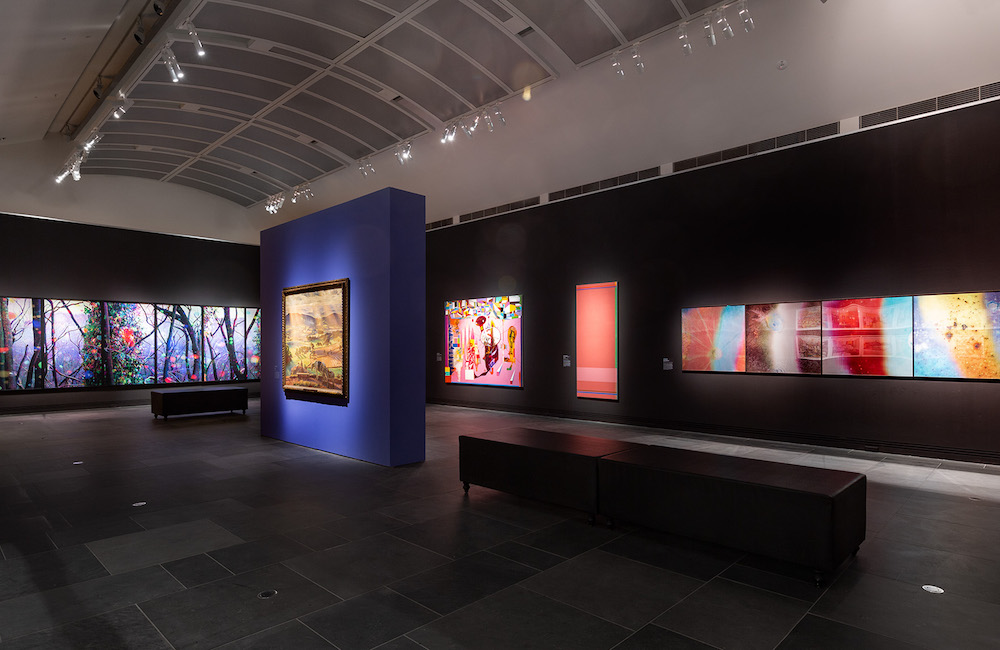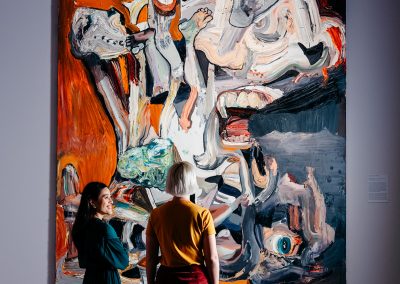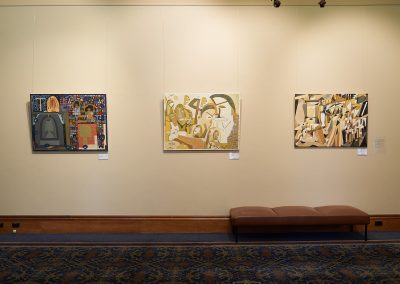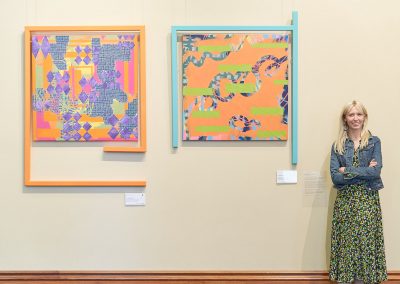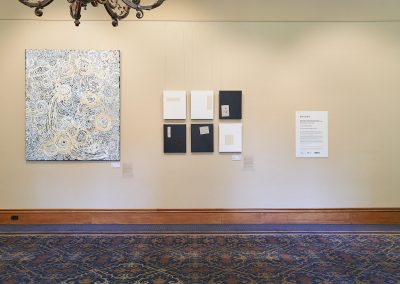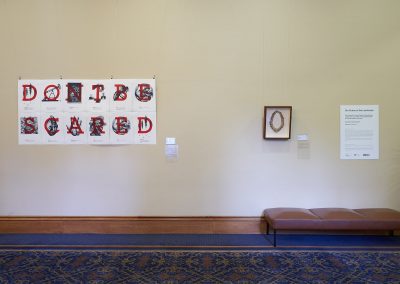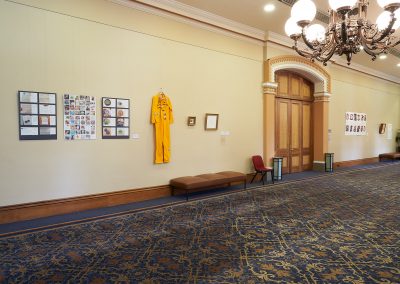An emerging perspective on the current and future role of curating
By Steph Cibich
‘Curating changes with change in art.’ Hans Ulrich Obrist, Ways of Curating (2015)
I remember the first time I read Ways of Curating by Hans Ulrich Obrist. It was a few years ago and I was on the brink of studying a Master of Arts (Curatorial and Museum Studies) at the University of Adelaide. I was hoping to simply familiarise myself with the work of this legendary figure but was completely taken back by the author’s honesty and the generous insights offered into his practice. My interpretation of the book opened my eyes to the multifaceted responsibilities and challenges encountered regularly by curators and the ongoing evolution of the role. I was hooked.
Now, in 2021, after completing my studies and gaining some experience curating my own exhibitions, I find myself, at the end of my tenure as the inaugural ART WORKS Emerging Curator, a program presented by Guildhouse and the City of Adelaide. My role commenced at the start of 2020, when Australia was on fire and spanned the onset of COVID-19, witnessing some of the most unprecedented events in recent history. It also coincided with national gallery closures, programming overhauls and further reductions to arts funding, leading to an unintentional baptism of fire for someone still ‘green’ in their curatorial career. As many of us find ourselves reassessing and rethinking the way we do things in the shadow of 2020, I took the opportunity to do the same; to take stock, reflect and reconsider the current role of the curator in these times and to contemplate the future landscape of the curatorial field. To get the measure of things and to contextualise my own understanding, I discussed these ideas with Dr Lisa Slade (Assistant Director, Artistic Programs at Art Gallery of South Australia, Adelaide) and Andy Butler (Program Curator at West Space, Melbourne), two experienced curators working within different methodologies and in different spaces.
Curators are not just exhibition makers.
Although considered to be a fairly new profession, the activities covered by curators today are still well expressed by the Latin etymological root word, curare meaning ‘to take care of’. In fact, from the late eighteenth century the role of the curator came to represent someone who took care of a museum’s collection. This definition can also be applied to current approaches of contemporary curatorial practice, which, as Obrist describes, centre around ‘cultivating, growing, pruning and trying to help people and their shared contexts thrive’. This includes independent, organisation-based and collection-based curators who endeavour to find new ways of representing and interpreting objects to engage audiences and incite meaning.
However, the role of the curator is expansive. As Dr. Lisa Slade explains, ‘it’s important to acknowledge the many aspects of curatorial practice’ as exhibition making is ‘just part of being a curator’. Generally, the role also encompasses collection management, programming, audience development, scholarly research, the application of art historical knowledge and the facilitation and coordination of artists and artworks. It also includes writing interpretative and promotional material, project management, budget administration, overseeing artist commissions, acquisitions, loans and the delivery/collection of artworks. Many curators may be required to physically implement or supervise exhibition installation, write grant applications, coordinate with other departments or organisations, speak publicly, attend events and maintain long term relationships with artists and other key stakeholders.
Contemporary curatorial practice is also frequently underpinned by ongoing conversations and long-term relationships with artists. This ultimately informs the way a curator works by feeding their capacity to understand an artist’s practice and engage deeply with artworks. In turn, these conversations help curators to think critically and consider a work’s significance for audiences in the context of exhibitions and other relevant contemporary events.
Depicting his own experiences at West Space, Andy Butler describes the way ongoing conversations help him facilitate artists and are imbedded into his curatorial process. This process includes regular studio visits with individual artists over the course of at least twelve months. As Program Curator, Andy describes his role as primarily ‘about cheering them (artists) on, being a soundboard for their work, giving really constructive criticism and feedback… and trying to help them determine what they want their show to be.’ This process also includes assisting with professional development and working alongside the artist with everything ‘from the inception of the idea to its execution.’ Ultimately, Andy describes a curator as someone who is essentially ‘really good at running stuff, putting together a spreadsheet and being organised,’ someone who is ‘just part of the community.’
However, the curatorial field has also expanded beyond the communities of our arts ecology and now imbeds society in such a way that it has new colloquial meanings. In case you haven’t noticed, now curating also refers to Instagram feeds, clothing companies as well as food and beverage menus (curated gin tasting, anyone?), indicating the extent in which it has become part of our general understanding. The role of the curator has gained what Lisa describes as ‘broad accessibility,’ demonstrating that people are ‘interested in this idea of selection, of authoring….that someone has responded to circumstances or opportunities for them…that we need curators to make sense of our world and to respond.’
In terms of thinking about the current and expanding role of the curator, it makes sense that what curators do best is bring different forms of art and communities together in different ways and in various contexts. This act of meaningful selection invokes a dialogue between artists and artworks which, through audience engagement, can catalyse ideas and invoke meaningful moments of connection.
So, what is a curator responsible for?
To be honest, the responsibilities change. Just as curatorial processes differ between projects and professionals, so too will the requirements, obligations and expectations shift whilst working with diverse people, artworks and environments. A curator’s responsibility may then be subjective to the artist, the artwork, working with communities or dealing with sensitive subject matter. It could also relate to practical requirements or the limitations of working in certain spaces, available funding, timeframes and managing the expectations of other organisations or stakeholders.
However, there are some fundamental responsibilities which underpin current trends in curatorial practice. As Lisa describes, ‘one of the key responsibilities of being a curator is to get the measure of things. To have your ear to the ground and get a sense of what people are thinking feeling and expecting.’ This is an essential skill for connecting artists, artworks and audiences and rings true for most curator’s working during these strange times. Andy describes this responsibility when working closely with an artist as ‘helping them (artists) understand how their work fits into a broader discussion,’ which includes connecting artists with each other and ‘building networks in the community wherever possible.’ While getting the measure of things highlights the importance for a curator’s capacity to consider and reconsider past and present events, it also emphasises the potential power of art. Curators should pay close attention to the creative ways our communities are responding and processing events and ideas. By having a finger on the pulse, curators can then collaborate with artists to facilitate relevant and meaningful projects.
Another major responsibility for curators is their duty to the audience. This requires purposeful decisions about the selection of works and the kinds of exhibitions they wish to create, a process which should be managed collaboratively with the artist wherever possible. As Andy describes, ‘really, what you’re putting together, is a space for the public, that over a whole year, or a whole suite of programs, speaks to particular concerns and ideas and broader issues… trying to put it all together in way which actually feels quite meaningful.’
In the current climate of COVID-19, curators and galleries like the AGSA have a responsibility to offer what Lisa describes as ‘a place for reflection and connection…without the fear of proximity.’ By providing something accessible to the community in a time of crisis and uncertainty, Lisa says that galleries can act as ‘temples of humanism…they offer places where people can be human and can explore what it means to be human and reflect on particular circumstances or conditions.’
But there are also those unshakeable, personal responsibilities which relate to an individual’s unique way of curating. As the role continues to expand and take on many forms, a curator’s duty may reflect their own professional standing, experience or interests. These could relate to the personal objectives driving individual curatorial practice such as furthering their own research or a desire to share knowledge about the important work of particular artists. These responsibilities might also reflect the weight which comes with certain roles or with caring for a particular collection. Lisa discussed the personal responsibility she feels for needing to circulate artworks from AGSA’s collection as much as possible. This comes from an interest in ‘circulation and questioning or opening up the very dialogue around ‘what are the canonical works?,’’ whilst also respecting the need to display ‘touchstones’ which remain significant for members of the community.
It seems that the common thread between these responsibilities is a curator’s duty to offer audiences a unique and engaging experience – something which stimulates and challenges viewers, whilst also connecting them with what is happening now. Above all, curators are responsible for rethinking ideas and conjuring fresh ways of presenting works, thus offering viewers an element of surprise or discovery. By activating spaces in different ways and challenging the audience’s approach to thinking, curators can provide innovative experiences for people to engage with art and foster new meanings.
What does the future landscape of curating look like?
Of course, there is no curatorial crystal ball. Like most of us watching current events unfold, the one thing we can be sure of is that nothing is out the question. Yet, pondering the future landscape of the arts in light of these events can provide some insight into how future ways of curating may unfold.
The future role of the curator will likely expand beyond its current standing. But I believe it will always maintain a strong relationship to the roles and responsibilities underpinning present curatorial practice. Based on the current role of the curator as someone who essentially helps us make sense of things, future curating might extend its breadth beyond the arts and reach further into other aspects of our communities. Following this line of thinking, Andy hopes to see more curatorial practices framed as part of larger things ‘like writing, and art making and community building…. Because art doesn’t just exist in museums. Art exists in communities.’
The prospect of curating other projects beyond exhibitions has become a reality for many in the last twelve months. As we find our way through a COVID-19 world, there is still the risk that programs and exhibitions may be cancelled or postponed. 2020 witnessed many programs finding their online voice as a substitute for ‘the real thing’. Whilst it is never the same as a physical exhibition, there is much to be said for alternative curatorial projects and finding new ways to engage audiences. As Andy describes, ‘there’s this realisation that exhibitions aren’t everything… they take up a lot of resources and emotional energy.’ Instead, ‘there are other projects that you can do that are just as meaningful for people, that are a lot easier and less resource heavy or don’t require a space. Things are online, publications, talks, those things can be as fulfilling as exhibitions. Even though, exhibitions are important…doing those sorts of things for your community is really good.’
The idea that curators could expand their role to help facilitate communities speaks to one of the core responsibilities listed above; having an ear to the ground to understand what people are thinking and feeling. This aspect of the role holds relevance for curators working during these strange and evolving times. To help navigate this transition and pave the way for future curatorial practice, Lisa advises ‘what should curators be doing now? They should be looking at what artists are doing now. They should be reading what writers are writing now, they should be listening to what people are talking about now and they should be engaged in the now.’ Through an ongoing dialogue with artists, deep engagement with artworks and constant consideration for the audience, curators can continue to challenge our ways of thinking and offer alternative perspectives through the introduction of ideas and communal experiences.
To me, it feels as if the role of the curator continues to expand and evolve alongside the role of art. That is why it is so difficult to offer a succinct definition. However, in the shadow of 2020 and all that lies before us, it would not be odd to feel daunted by the task of setting out into the curatorial landscape as it looks now. Indeed, there is a lot of work to be done and a lot of ideas to sift through. But this can also be liberating. Whilst circumstances continue to develop and new ideas come to the fore, our communities continue to find creative ways of processing their times. In our highly visual and globalised culture, artists continue to rise to the task of producing works which distil or challenge our ways of thinking. Curators working alongside artists to facilitate various projects which then proliferate ideas. In turn, these projects offer new, meaningful moments of human connection. As time moves on, it is my hope that the role of the curator will remain as one which binds and inspires communities in what will be an ever-evolving world.
Bibliography
Obrist, Hans Ulrich. Ways of Curating. UK: Penguin Books, 2015.
Steph Cibich in conversation with Dr. Lisa Slade, 2021
Steph Cibich in conversation with Andy Butler, 2021
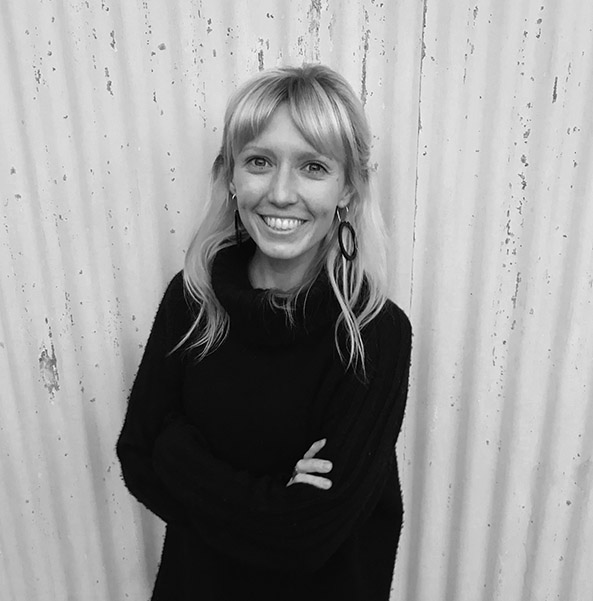
Steph Cibich
Steph Cibich is an Adelaide-based emerging curator with a passion for brining creative projects to life. She believes in arts palpable ability to help us lead more engaged and informed lives and is committed to the promotion of contemporary artists.
Steph is the Assistant Curator/Program Officer at the Centre for Creative Health and was selected as Emerging Curator for 2019 by the Art History and Curatorship Alumni Network and Floating Goose Studios. As part of this program, she curated the exhibition Material Connections at Floating Goose (SALA 2019) and was awarded the City of Onkaparinga Contemporary Curator Award.
Steph founded Art Vending Machines Australia (AVMA) in 2019 – a public art initiative that launched its first ‘Adelaide Art Vending Machine’ at the Art Gallery of South Australia (AGSA) and came to life while Steph undertook an internship as part of her Master of Arts (Curatorial and Museum Studies) at the University of Adelaide (2018).
In 2017 Steph received AGSA’s Excellence Award for Marketing and Development support and completed a 12 month internship at Artlink Magazine.


